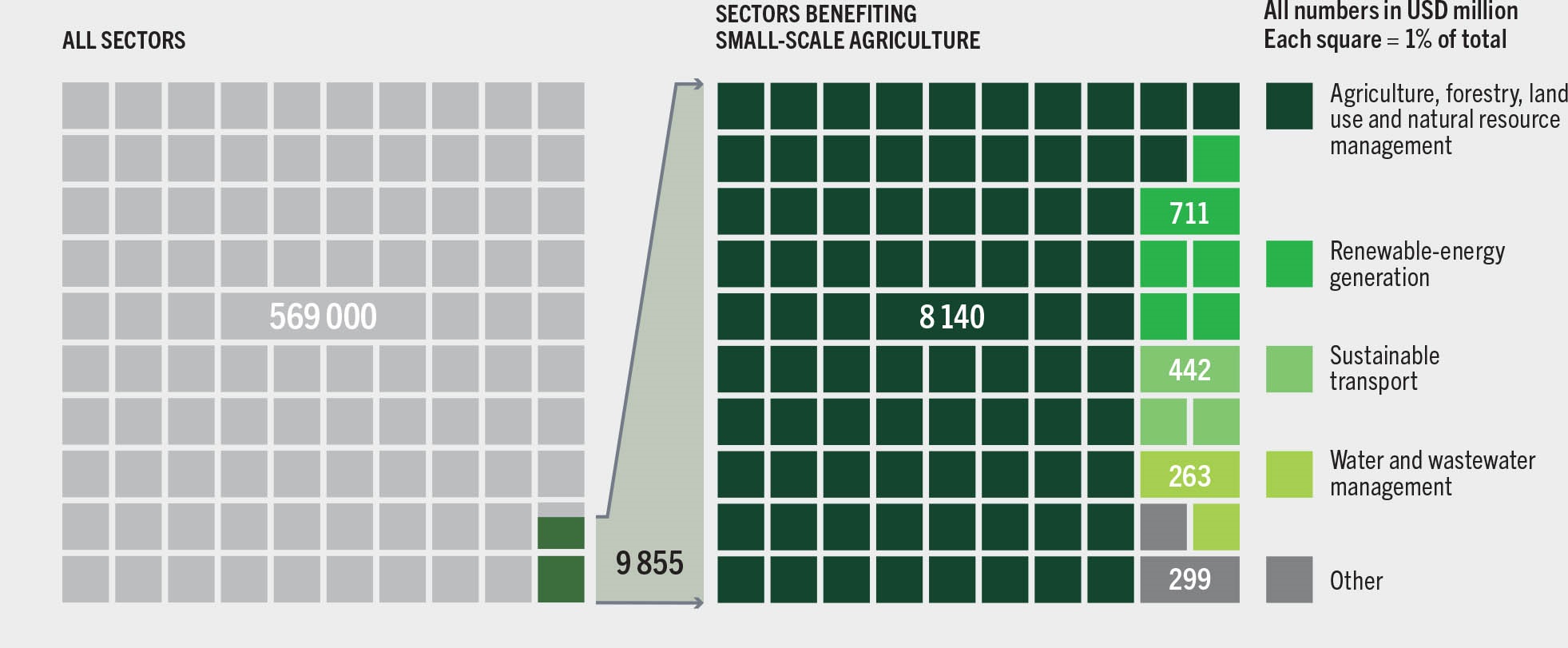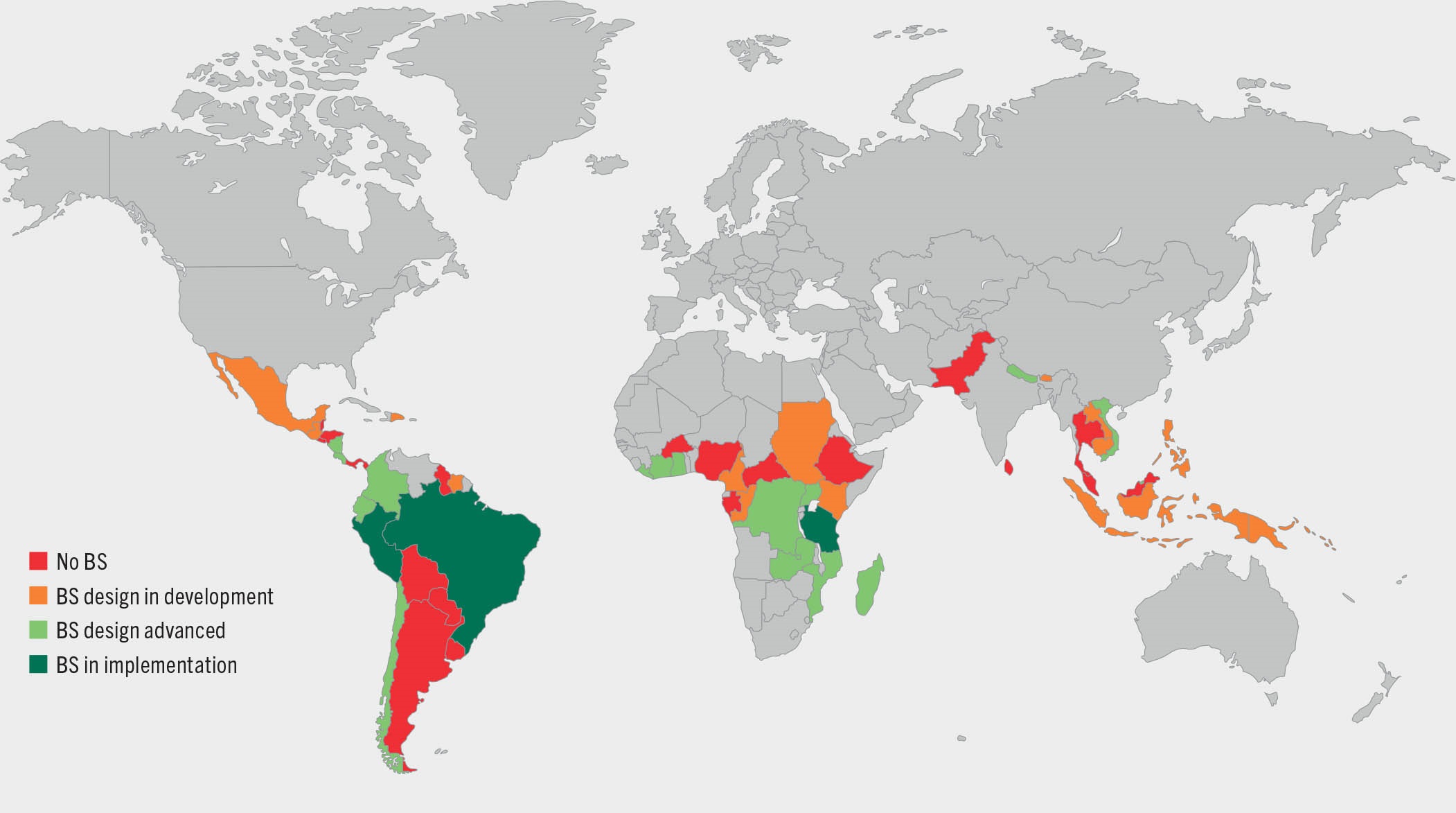Despite being key stakeholders in many forest value chains, smallholders are often perceived to carry additional costs and risks for investment projects, for example because of a lack of collateral. High transaction costs due to value-chain fragmentation, the informal nature of trade interactions, and scalability issues are additional barriers to investments in smallholder-driven projects.406,407
Small producers received less than 1.7 percent of climate finance in 2019, and the situation does not appear to have improved since
Small farms (i.e. less than 2 ha) account for 84 percent of all farms worldwide; they operate on about 12 percent of all agricultural land but produce roughly 35 percent of the world’s food.408 Small farms receive a very small amount of climate finance (Figure 22) – less than 1.7 percent of such flows in 2019.409 Donor support to Indigenous Peoples and local communities for forest management was reported at USD 250 million to USD 280 million per year between 2018 and 2020.410 This amount could increase significantly following the UNFCCC COP 26 pledge to allocate USD 1.7 billion between 2021 and 2025 (representing roughly twice as much funding from bilateral sources and foundations as in the previous period) to advance the forest tenure rights of Indigenous Peoples and local communities and support their role as guardians of forests and nature.411
Figure 22Proportion of climate finance benefiting small-scale agriculture

SOURCE: Chiriac, D. & Naran, B. 2020. Examining the climate finance gap for small-scale agriculture. Climate Policy Initiative.
(also available at https://www.climatepolicyinitiative.org/publication/climate-finance-small-scale-agriculture).
New approaches are helping mobilize investment for smallholders, including to reduce perceived risks for investors
Strategies to de-risk smallholder projects, such as using trees as collateral for loans (Box 27) and building assets based on income from ecosystem services (Box 28), can mobilize more investment in small-scale stakeholders.
Box 27Tree collateral in Asia – tapping into forest smallholder wealth
In Thailand, the current value of standing trees is used as part of loan collateral arrangements for smallholders organized through local groups called tree banks.412 In Indonesia, a public programme enables smallholders to use their trees as collateral for loans to extend rotation periods and thus avoid premature harvesting.413 In the Lao People’s Democratic Republic, the availability of plantation certificates for smallholders enables access to microloans from a rural savings and credit union. These certificates are accepted by sawmills or intermediaries to back advance payments for the plantations two years before harvest.414 In India, smallholders can receive loans for plantation establishment from financial institutions, with timber companies providing buyback guarantees and backing such loans as guarantors.415
Box 28Trees for Global Benefit – a scheme for building farmer assets based on their ecosystem services
The aim of the Trees for Global Benefit programme coordinated by Ecotrust in Uganda is to scale up the positive impacts that small and medium-sized enterprises and smallholders have on forest ecosystems. It seeks to aggregate ecosystem services provided by small farmer-led initiatives to restore tree cover and sustainably manage forests, sell these to international markets and distribute the proceeds to the farmers and enable them to access productive loans from formal financial institutions. Such loans are then used to strengthen sustainable agricultural and forest-based activities, such as honey production and the expansion of reforestation activities. More than 10 000 farmers are participating in the programme on more than 8 000 ha of land. In 2019, carbon credit sales to private entities generated 70 percent of the total financial flows (USD 2 million) in Trees for Global Benefit.416
Production risks to smallholders need to be addressed to encourage them to invest in improvements in their operations. Measures include capacity development, increasing access to inputs, and efforts to link smallholders to markets. Viable social-protection systems (e.g. social assistance and social insurance, which can include subsidized agricultural or other insurance) can also mitigate risks. De-risking investments in smallholders and small and medium-sized enterprises requires an integrated approach that addresses risks for both investors and investees. Helpful examples are available in the agriculture sector – such as for cocoa in West Africa.417
Benefit-sharing mechanisms for REDD+ are emerging, but full implementation is limited despite readiness efforts in many developing countries
Benefit-sharing is “the intentional transfer of monetary and nonmonetary incentives (goods, services or other benefits) to stakeholders for the generation of environmental results (such as GHG emission reductions) funded by revenues derived from those results”.418 Although there is no universal definition, the concept of REDD+ benefit-sharing refers to the set of institutional means, structures and instruments aimed at enabling the distribution of benefits from REDD+ programmes among stakeholders. According to Bertzky et al. (2021), most countries are still at an early stage of development in their benefit-sharing mechanisms (Figure 23),419 but good practices and key success factors have been identified from existing mechanisms. The slow uptake is due in part to the limited financing channelled through RBPs.
Figure 23Stage of development of benefit-sharing mechanisms under REDD+ in the 54 countries supported by UN-REDD, the Forest Carbon Partnership Facility and other initiatives

SOURCE: Bertzky, M., Canosa, O., Koch, A. & Llopis, P. 2021. Assessment report – Comparative analysis of benefit-sharing mechanisms in REDD+ programs. World Wide Fund for Nature. (also available at https://wwfint.awsassets.panda.org/downloads/wwf_assessment_report_redd__programs_v4.pdf).


